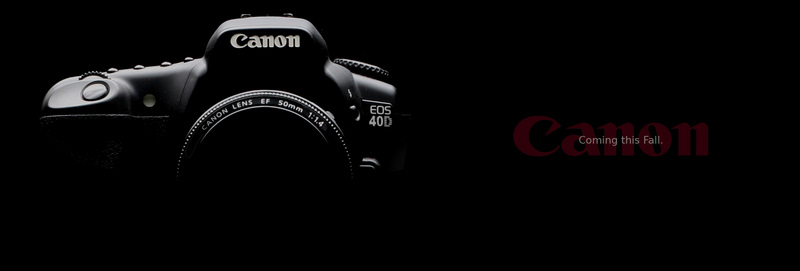This time, we are nearing the full confirmation that the Canon EOS 40D will be present in the photo stores on September 2nd. Some US Internet users tried to collect direct data and learned that the camera is expected in stock at Best Buy (pre-orders would be accepted from some brick-and-mortar stores) at this date and with a $1599 price sticker (seeing the buzz around it while there is still no official announcement and no camera has been seen out of very closed circles, I have to understand the position of Canon willing to take advantage of the public rush and keeping relatively high prices compared to the $1500 normally requested for a Canon 30D).
 Meanwhile some Canon web sites (including China) started experimenting with the removal of the 30D from very visible lists (for example, removal of the 30D from a graphical list of products). All is well in accordance with the preparation of an imminent launch for the EOS 30D.
Meanwhile some Canon web sites (including China) started experimenting with the removal of the 30D from very visible lists (for example, removal of the 30D from a graphical list of products). All is well in accordance with the preparation of an imminent launch for the EOS 30D.
The AF (auto-focus) system of the 40D would come from the Canon 1D Mk III but in a slightly simplified version. Since we already knew that it would only have 9 AF zones (instead of 19 crosses). “1D Mk III-lite” merely seems to mean that they will use a common algorithm and a simplified AF-sensor set. Hard to say if this will have a performance as impressive as the 1D Mk III.
Nobody is expecting weather-sealing anymore (the 40D will have about the same build as a 30D) and everybody seems to be convinced that the sensor will be a 10MP CMOS sensor with a crop factor of 1,6 (but I keep wondering whether they would bring an even more attractive 12MP in a market already full of 10MP sensors) along with 14-bit Digic-III for the best possible RAW image quality. The ISO-sensitivity should be a major pro of this camera with ISO 100-3200 + 6400h (image quality would be significantly improved from the 30D, leading to one of the best images of the market). All this is protected by active dust cleaning of the sensor (but we are still hoping that they did not copy the relatively poor 400D and went for the excellent DC technology of the 1D Mk III).
The Canon EOS 40D would be able to go as fast as 6,5 frames/second to beat the direct competition of the Nikon D200 (let’s wait for the Nikon D300) with a big buffer (60 JPEG images, 12-15 RAW images). But this enormous speed could be limited by the user from the menus (normal photographers would certainly be in a hot spot trying to avoid double photos with this feather-light-trigger machine; So, Canon decided to offer a confortable saddle to the cow boy who would be afraid to ride bareback this hot-blooded stallion).
If you add the superb 3″ LCD screen, you get a magnificent photo machine that should excite most expert amateur photographers, even more if she has a set of good Canon lenses already available.

Leave a Reply